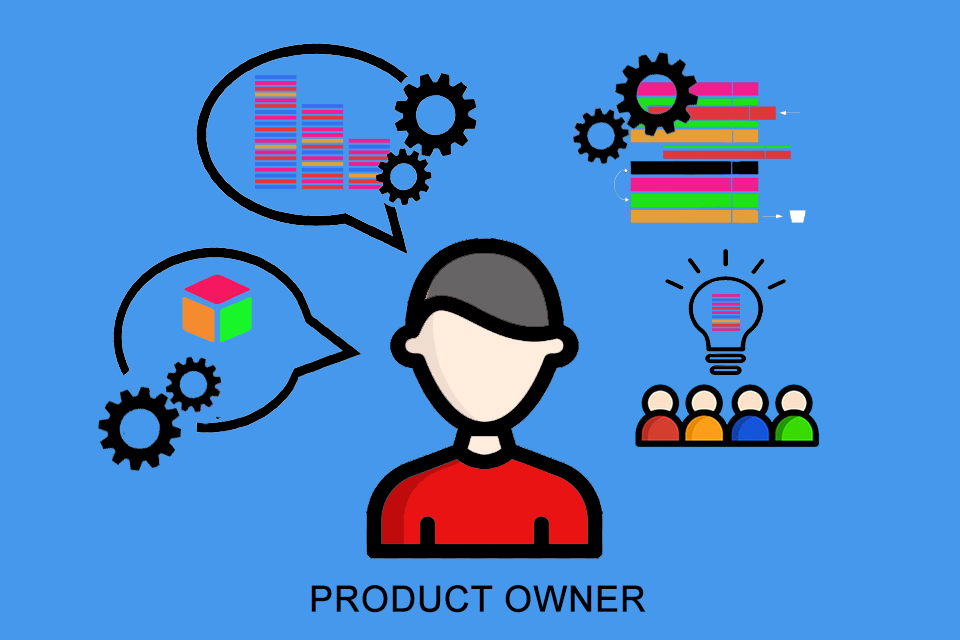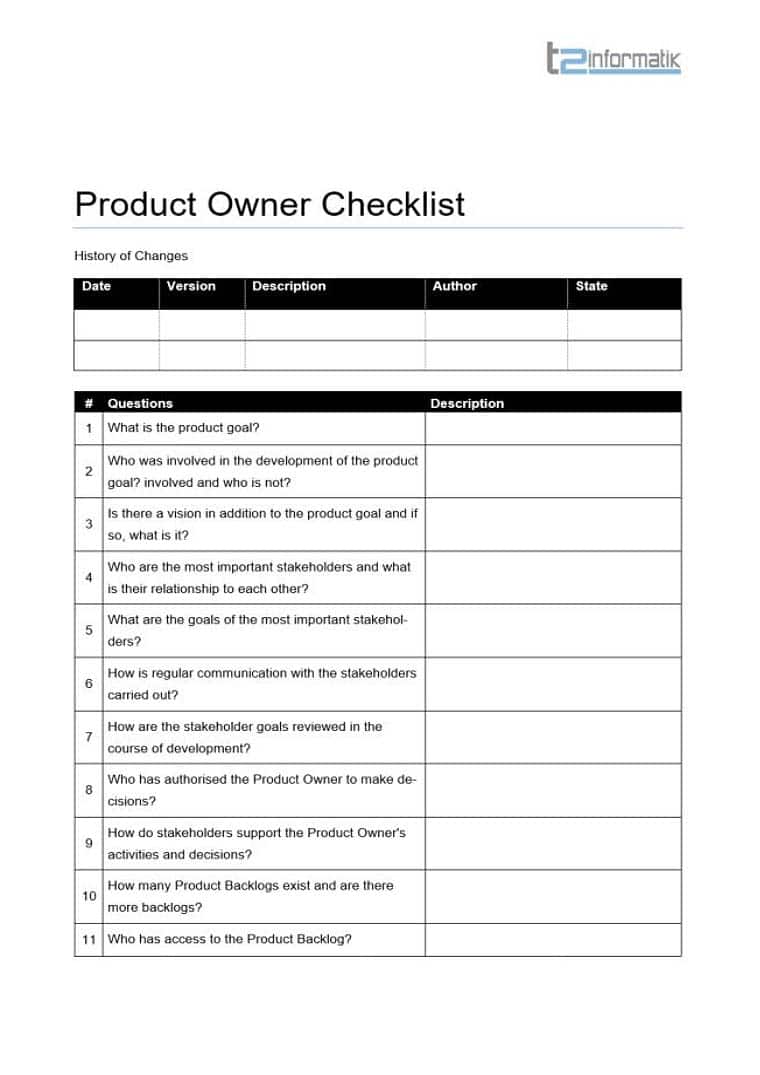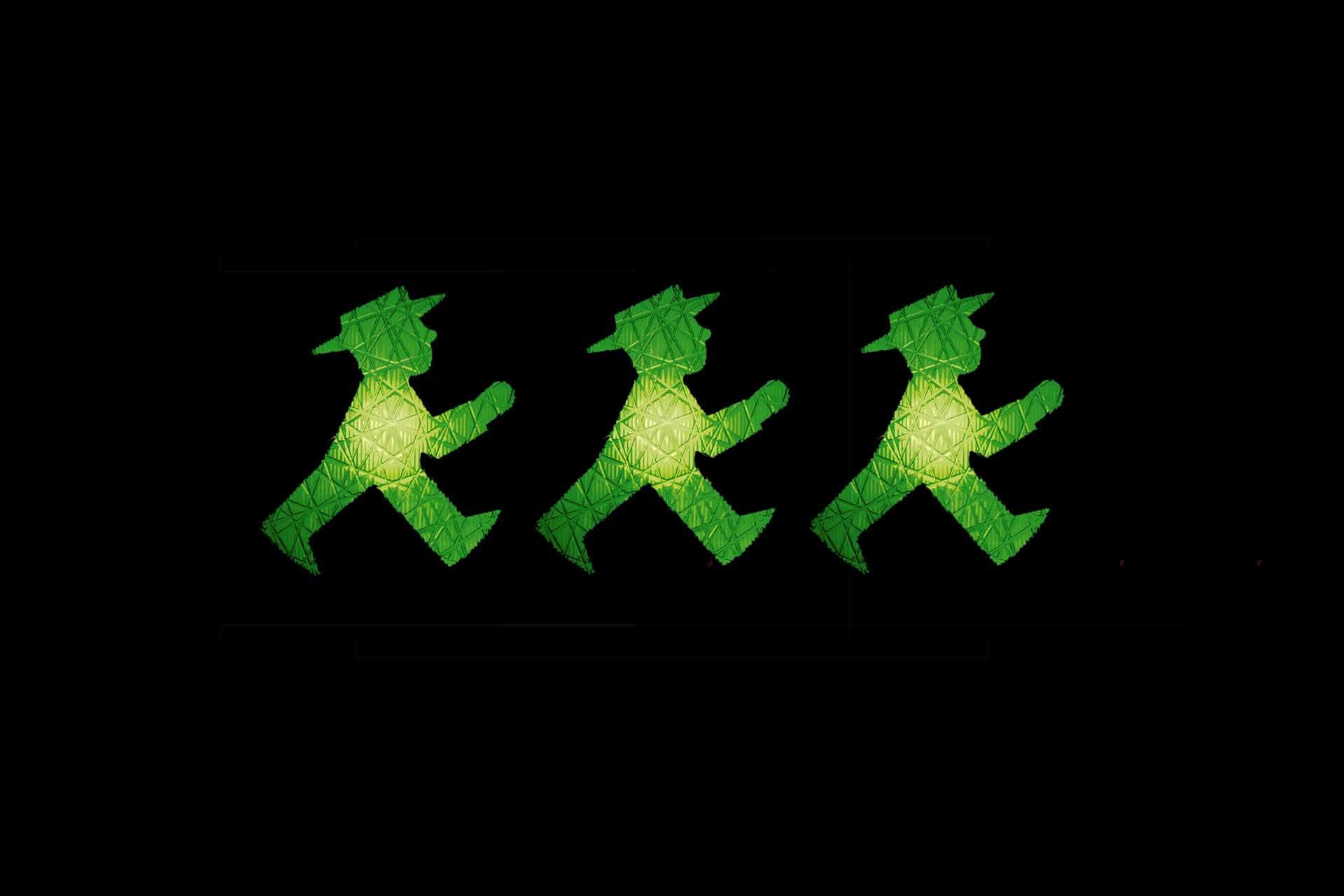What is a Product Owner?
Table of Contents: Definition – Tasks – Activities in practice – What is NOT a PO? – Certification – Questions from the field – Checklist – Notes
Smartpedia: In Scrum, the Product Owner is responsible for adding value to the product and is responsible for both the Product Backlog and the Product Goal.
Product Owner definition
Scrum defines three accountabilities:
- the Scrum Master,
- the Developers and
- the Product Owner.
The Product Owner is responsible for increasing the value of the product in the development process and is responsible for the Product Backlog and Product Goal.
In practice, he is often the one who represents the technical viewpoint and acts as the contact person for the developers. Among other things, he formulates requirements for the desired solution and assesses development progress based on functionality, usability and quality.
The tasks of the Product Owner
According to the current Scrum Guide 2020 the Product Owner has the following four tasks:
- Developing and explicitly communicating the Product Goal;
- Creating and clearly communicating Product Backlog items;
- Ordering Product Backlog items; and,
- Ensuring that the Product Backlog is transparent, visible and understood.
In addition, the Scrum Guide states that the Product Owner
- may delegate the above tasks, but he is responsible for them.
- is responsible for maximising the value of a product through the work of the Scrum Team.
- represents the needs of the stakeholders, but changes to the Product Backlog will only be made if he, as the responsible person, is convinced of them.
- is the person with whom the scope can be clarified in a sprint and, if necessary, renegotiated in an ongoing sprint as soon as new insights become available.
- has the authority to cancel a Sprint.
- ensures that the participants in Sprint Planning are prepared and able to discuss the most important Product Backlog Items on the way to the Product Goal.
- suggests in Sprint Planning how the product could increase its value and utility in the current Sprint.
- participates in the Daily Scrum as a developer and therefore as part of the Scrum team.
- supports the developers in sizing the items in the Backlog Refinement if required
- is a person and is not a group or committee.
In order for the Product Owner to work successfully – according to the Scrum Guide – the whole organisation has to respect his decisions, which can be seen through the content and order of the Product Backlog Items, as well as the Increments at the end of the Sprints.
Further activities in practice
In addition to the tasks in the Scrum Guide, there are also practical activities that often fall within the Product Owner’s field of activity, such as
- the regular communication with stakeholders, and thus also the promotion and representation of their needs.
- the responsibility for releases and release plans. Whether the roadmap of the product to be created is his responsibility or that of the Scrum Team depends on the context.
- the clarification of Backlog Items in the Sprint Review, which have been completed or are still open (which should not be presented as such).
- agreeing the Sprint Goal with the Developers and clarifying the User Stories to be implemented.
In addition, it is often the technical contact person for the Scrum Master and the Developers and should be available regularly and ideally also at short notice for questions.
In practice, there are always discussions about whether the Product Owner has the overall responsibility for the product and is responsible for the success of the product and, in the end, for marketing, sales, development, operation and support. It is advisable to consider the specific context of an organisation and to find a common understanding of the responsibilities, tasks and roles, especially since in many organisations it would already be a success if representatives of the above-mentioned areas participated in the Sprint Review.
What is NOT a Product Owner?
It is important to understand what a Product Owner is NOT:
- He is not the project manager – he does not exist in this form in Scrum.
- He is not the superior of the Developers – due to the self-determined approach of the Scrum Team, which is based on the principles of the Agile Manifesto and the promotion of self-management in the Scrum Guide, there is no such leadership role.
- He is not the moderator in various Scrum events such as the Daily Scrum.
He can, but does not have to be a manager in the line organisation; what is important is the ability to represent the stakeholders in a technically competent way. In principle, the Scrum Master should intervene if necessary and ensure that the accountabilities defined in the Scrum Guide are observed. In order to avoid possible conflicts of interest, the Product Owner should not have a double function as Scrum Master or Developer.
It is often claimed that the Product Owner as a representative of the users is responsible for the formulation of User Stories. This is not the case. Apart from the fact that it is context-dependent which elements are managed in the Product Backlog, it is ultimately secondary who formulates them. The responsibility for the Product Backlog and the Product Goal lies with the Product Owner, but most importantly it is important that users and developers understand each other. The Product Owner must make his contribution to this. How he does this depends on the situation. And how well he does it can be discussed in Retrospectives.
Product Owner Certification
There are two acknowledged Product Owner certificates:
- Certified Scrum Product Owner (CSPO), offered by the Scrum Alliance¹
- Professional Scrum Product Owner (PSPO), offered by Scrum.org²
Just like the distinction between the Certified Scrum Master (CSM) and the Professional Scrum Master (PSM), the main difference between the CSPO and the PSPO is the type of certification. To obtain the CSPO certificate, a training course – conducted by a Certified Scrum Trainer (CST) or a Certified Enterprise Coach (CEC) with a subsequent test – is required. The PSPO certificate does not require any training, only the passing of a test.
After the CSPO or PSPO there are further levels for certified product owners:
- Advanced Certified Scrum Product Owner (A-CSPO), offered by the Scrum Alliance
- Professional Scrum Product Owner II + III, offered by Scrum.org
Like all certificates of the Scrum Alliance, the CSPO must be recertified every two years. At Scrum.org there is no such requirement.
Questions from the field
Here you will find some questions and answers from the field:
Is the Product Owner based in the business department or in IT?
Does the Product Owner come from the business department or IT? In many companies there are considerations as to where the Product Owner should be located. Most organisations prescribe the role (and also the accountability) – if not provided by the external client – in the business department.
Depending on the context, however, the answer may vary: if, for example, the organisation is a corporate group or is undergoing an agile transformation, the Product Owner may also come from IT, for example to guarantee the ongoing operation and security of a solution. But even in such a situation, the business department must “set the direction” and the IT department must ensure that everything “necessary” is taken into account, because only then is the “customer focus” above the “system focus”. In the sense of continuous improvement, it can also make sense to raise such and similar issues in organisations again and again and continuously search for the best individual solution.
How much does a Product Owner earn?
The salary of a Product Owner in Germany varies depending on experience, location, company size, industry and gender. And it also varies depending on the source you look up on the internet.
According to rollthePay and JobertyBlog, Product Owners receive the following salaries on average:
- Junior PO (less than three years of professional experience): 44,000 to 65,000 euros gross per year.
- Experienced PO (between three and approx. 7 years of professional experience): 65,000 to 89,000 euros gross per year.
- Senior PO (more than approx. 7 years of professional experience): Up to 100,000+ euros gross per year.
On average, the salary of a Product Owner is around €66,000 to €70,000 per year. Salaries tend to be higher in large cities such as Munich, Frankfurt and Stuttgart, while smaller cities and companies often pay less. Bonuses and other additional benefits are also common and can add to the salary.
According to the Kununu review platform, the average annual salary for a PO in Germany is around €71,200 gross. Women earn an average of 65,600 euros, while men receive an average of 73,600 euros. Salaries range from 52,200 to 105,600 euros gross per year, with the majority of salaries between 62,880 and 73,560 euros.
You may know someone who earns less or even more; this is not unusual, as the figures are intended as a guide at best.
What is the difference between a Product Manager and a Product Owner?
The question of the differences between a Product Manager and a Product Owner is particularly relevant in companies that use both traditional and agile methods. Scrum as an (agile) framework defines three accountabilities ( Scrum Master, developer and the PO), but it does not recognise a product manager. The product manager that exists in many traditional companies has no direct equivalent in this form in agile environments.
In practice, it can be observed time and again that the activities of the Product Manager and the Product Owner are not always clearly delineated in many organisations, which leads to overlaps, ambiguities and conflicts. This lack of clarity can impair efficiency, as it remains unclear who is ultimately responsible for which decisions. While some organisations strictly separate the activities, in others they run into each other, which can lead to unhealthy competition or a power vacuum.
If both roles exist in an organisation, a difference in strategic and tactical orientation can often be observed: The product manager is primarily strategically orientated. They define the long-term vision and strategy for the product based on market analyses, customer needs and business requirements. In contrast, the PO is more tactically orientated. Their main task is to translate the product manager’s strategy into concrete requirements for the development team and to ensure that these are implemented efficiently.
There are also significant differences in terms of decision-making authority and influence. The product manager often has comprehensive decision-making power over the product and is responsible for the entire product life cycle. They make decisions that affect the big picture and act as a kind of ‘mini-CEO’ of the product. The PO, on the other hand, operates within the guidelines set by the product manager and concentrates on managing day-to-day operations. Although the PO has the autonomy to make decisions about the ‘what’ in the context of development, this is always in line with the overarching strategy. The ‘how’ is usually determined by the development team in an agile context.
In some publications, the market focus and team focus are also mentioned as distinguishing features. The product manager would interact regularly with stakeholders in an outward-looking manner to ensure that the product is market-orientated and competitive. The Product Owner, on the other hand, would be more inward looking and would focus on working closely with the development team to ensure that requirements are clear and teamwork is organised effectively. In fact, the relationship between market and team focus in an agile context is more complex than this superficial view.
While it is true that the PO is primarily responsible for communicating with stakeholders and ensuring that the product vision and requirements are clearly formulated, the development team also plays an important role in this process: developers should actively interact with stakeholders to truly understand what they need to achieve their individual vision and goals. During a review meeting, for example, there is the opportunity to receive direct feedback and develop a better understanding of the actual needs and challenges of the stakeholders. This not only promotes stronger identification with the product, but also enables the team to proactively develop solutions that go beyond the mere fulfilment of requirements.
If both roles exist in a company, a clear differentiation and demarcation is highly recommended as a conscious organisational decision. Failure to do so can lead to inefficient processes, duplication of work and ultimately failure to meet product targets. Clearly assigning responsibilities, maintaining strategic and tactical separation and encouraging collaborative working are crucial to realising the full potential of both roles.
What is the difference between a Product Owner and a Scrum Master?
- maximising the value of the product to be developed and
- effective product backlog management including the development and communication of the product goal, the creation and communication of the backlog items with the definition of the sequence.
In addition, they must ensure that the product backlog is transparent and visible and that the items are understandable.
The Scrum Master is accountable for the effectiveness of the Scrum team. To achieve this, he addresses his activities both towards the developers and the Product Owner, as well as towards the organisation. In detail he
- supports the developers in self-management, interdisciplinary collaboration and focussing on the increment to be created, if necessary helping to eliminate impediments and ensuring the productive, positive execution of Scrum events including adherence to the timebox.
- supports the PO with techniques for defining the product goal and for backlog management, with empirical product planning and, if necessary, with collaboration with stakeholders.
- helps the organisation, for example, with the planning and introduction, training and coaching of Scrum, conveys the attitude and empirical approach of Scrum, ensures a better understanding of Scrum and between those involved, including stakeholders.
Here you can find more information about Scrum Accountability.
Download the Product Owner Checklist for free now.
With the checklist, you record various information that is essential for the Product Owner’s work:
- What is the product goal?
- Who are the most important stakeholders, what are your goals and how are they reviewed?
- How do you work with backlogs?
- How does the cooperation with the Scrum Master and the developers work?
Checklist as working tool for Product Owners.
Not only the Product Owner should talk to stakeholders, but also team members are encouraged to exchange information with users, for example. From the stakeholders’ point of view, how does this work if they have numerous contacts?
Notes:
[1] Here you can find additional information about the Scrum Alliance.
[2] Here you can find more information about Scrum.org.
By the way, the LeSS Huge Framework knows Product Owner Teams.
Here you can download a Scrum Whitepaper.
If you like the article or would like to discuss it, please feel free to share it in your network. And if you have any comments, please do not hesitate to send us a message.
Here you will find additional information from our t2informatik Blog:




